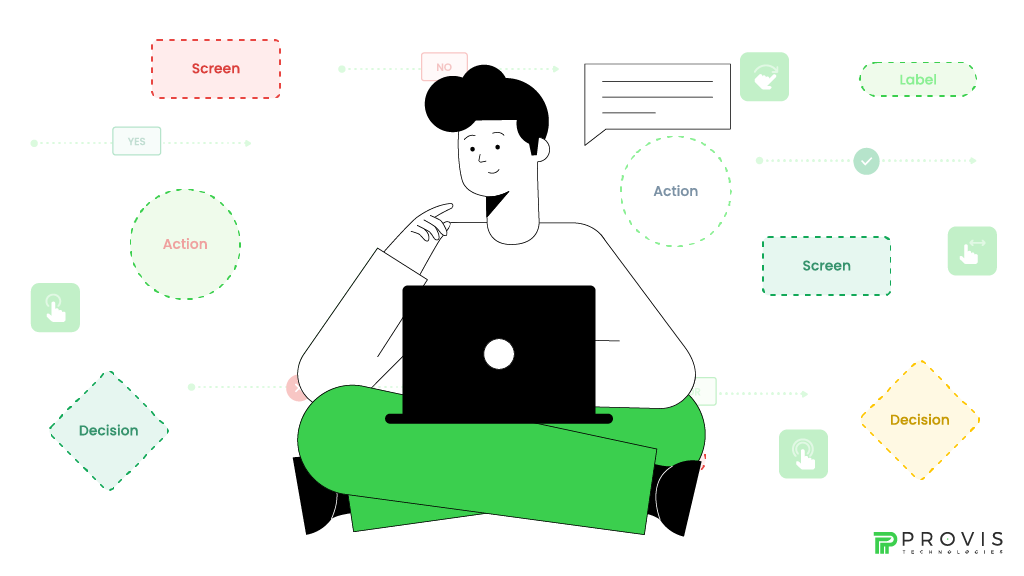How to create a user flow is the key to optimally navigated and easy-to-use digital experiences. When you are developing a website, application, or any kind of digital product, the user flow is a make-or-break factor in success. This also includes how users engage with your work.
To help you understand more about how to create a user flow and its importance, this Provis Technologies guide has got you covered. Let’s dive in!
What Is a User Flow?
User flow is mapping out the steps a user will go through to complete an objective for a given service. It is more like the roadmap where navigation from one point to the other is smooth. The main purpose of a user flow is to assist the user in achieving his or her goals.
For instance, if you are wondering how to create a user flow diagram where a user needs to purchase shoes from an e-commerce application.
Their flow might look like this:
The user lands on the homepage >> browses or searches for shoes >> clicks on a specific shoe to view details >> adds the shoe to their cart >> enters shipping and payment details.
And finally, the user completes the purchase on the confirmation page.
This simplification enables the user to accomplish what they set out to do without much frustration.
Why Are User Flows Crucial in 2025?
The expectations that the users have in 2025 will be at an all-time high. Today, users are streamlined and they expect interactions to be the same. As a result of the AI and personalization of their interactions, they expect smooth experiences. Good user flows can minimize the number of drop-offs. This leads to an increase in conversions.
Similarly, when using an e-commerce site, if users can flow through the site easily, it increases their purchasing chances. Along with this, there is nothing more effective than an optimized sign-up process to boost users’ registrations in SaaS platforms.
It is also handy to use user flow for app development process for agility. They act as a reference for the goals the user has to enable the designers to be on the same page. This way, a team can move fast in developing prototypes and efficiently test to enhance the user needs.
Tools You Need to Create a User Flow in 2025
Creating user flow becomes easier when you work with the correct tools.
Some of the most used tools are Figma, Miro, Lucidchart, and FlowMapp.
- If you are confused about how to create a user flow in Figma, it has everything you need. It is perfect for a workflow for sharing design and prototyping across multiple individuals.
- Miro stands tall in brainstorming and visually creating the flow of users with the help of a canvas.
- Lucidchart is helpful for detailed diagrams to add plans and methods by drag and drop option and it also has different user flow templates.
- FlowMapp is a tool primarily created for those who are aiming toward user flows for exceptional UX and site maps.
How To Create a User Flow Chart
To design user flows, you need to bring it to an organized pattern to understand the user goal. Here’s a step-by-step guide:
1. Define User Goals
Begin with the expected goal that the users always want to achieve when they are using your product. Their goals include:
- Making a purchase
- Requesting a sample free of cost
- To explore landscapes
- Acquiring information
2. Analyze Your Target Audience
For creating user flows effectively, you should have a vision of the user. This will help you answer your query about how to create a user flow. Such as:
- Creating User Profiles: These should be demographic information, frequency, and goals.
- Conducting Research: Use tools such as questionnaires and interviews.
- Leveraging Feedback Tools: Some platforms include testing software or feedback forms to help enhance knowledge.
3. Map Out the User Journey
Envision the road map through which users move in order to accomplish their needs. Focus on:
- Key interactions
- Decision-making points
- Emotional states at each stage
4. Create a Wireframe
Wireframe is a low cognitive map that defines the minimum structure of flow for the particular user. It emphasizes functionality over design details about how to create a user flow.
- You can use Figma or even pencil and paper.
- Wireframes assist in easy modification based on the clients’ reviews and suggestions.
5. Test and Refine
Testing helps validate the flow established by its end user. Moreover, you can use these for testing:
- A/B Testing: The main goal is to contrast flow versions to determine the best-performing one.
- Usability Testing: Collect real feedback from users to know the problems faced.
- Behavior Analysis: Applications like heatmaps can help identify the areas of confusion in user interactions.
Difference Between User Flow And User Journey
Even though user flow and user journey are terms that are used in related contexts, these two are not the same thing.
A USER FLOW selects certain actions that a user may perform. One of the user flow examples is to put an item in a cart and check out.
On the other hand, a USER JOURNEY depicts all the interactions a user has with your brand starting from product recognition to ordering and getting help. Apart from this, how to create a user journey flow is a completely different process from a user flow.
Mistakes to Avoid When Designing User Flows
When working on user flows there are also some mistakes to remember.
Trying to keep the process too intricate ends up confusing the user. Therefore, it must be kept as simple as possible. Designers who do not pay sufficient attention to their users’ needs will end up with designs that do not meet expectations. Hence, collecting feedback and incorporating new actions is a must.
Another mistake is to not include a testing phase in how to create a user flow diagram for website.
Also Read: How IT Audit Services Work
Future Guidelines On How To Design User Flow In 2025
- To retain customers, design for a mobile-first approach, as most customers view your product on their phone.
- Consider a design for your site’s accessibility to make it as easily usable by those with disabilities as possible.
- Do not add on procedures in a way that might complicate the flow and obstruct the user’s interaction with the website.
- Implement the use of analytics to regularly monitor users’ activity and make changes if needed.
The Bottom Line
How to create a user flow is more than art, it is equally science too. Moreover, it comes back to understanding your audience, defining clear goals, and getting the correct tools, to create impactful and engaging experiences. In 2025, a modern user will once again step ahead of your competition as expectations continue to rise. So, what are you waiting for? Begin mapping your user flows right now!
Written By
Author's Picks
Categories
- AI for Startups
- AI in Web Development
- AI Integration
- AI Platforms
- AI Prompt
- AI Tools
- AI Trading Software
- Android App
- Android vs iOS Development
- Angular
- API
- API Development
- App
- app development
- App Idea
- App User Feedback
- Application
- Artificial Intelligence
- Audit Services
- Automotive Industry
- Awards and Recognition
- Business Consulting
- Business Website
- Chatbots
- CRM
- CRM for Financial Advisors
- Custom CRM
- Custom SaaS
- Custom Website
- Customer Service
- dashboard design
- Developing a Mobile App
- Digital Business
- E-commerce
- EMR Integration
- Finance
- Financial Advisors
- Financial Advisors
- GIT
- Health Insurance
- iOS App
- iOS App Development
- IoT Mobile App Development
- IoT Platforms
- IT Audit Services
- IT Consulting
- IT Strategies
- Java Development
- Laravel
- Lean Canvas
- Learning Management System
- Logistics Apps
- Mobile App Development
- MVP
- Native App
- News Aggregator Site
- OTT
- Outsourcing IT
- Payment Gateway
- predictive analysis
- Product Launch Strategy
- Progressive Web App (PWA)
- Prototype
- Recommender Systems
- Ruby
- SaaS
- SaaS Application
- SaaS Business
- SaaS Company
- SaaS Development
- SaaS Product
- SaaS Project
- Sales Funnel
- SEO
- Shopping Cart
- Software Development
- SSL and TLS
- Startup Checklist
- Technology
- Tetradic Color Scheme
- UI/UX Design Company
- Unit Testing
- User Flow
- User Testing
- Web Development
- Web Performance Optimization
- website Maintenance Services
- Website Migration Service
- Website Speed Optimization
- WooCommerce
- WordPress





